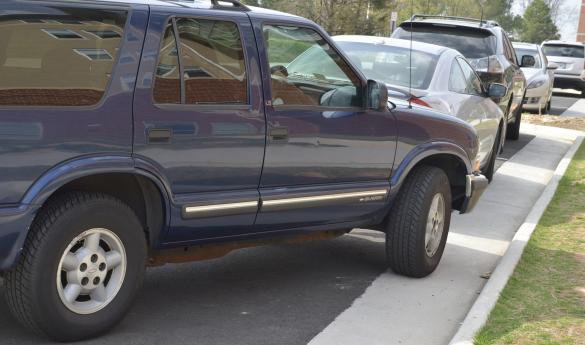SG working on SafeRides program like JMU’s
Student Government expects over the next few weeks to send a proposal for a SafeRides program to be approved by Todd Rose, associate dean of university life, and Josh Cantor, director of parking and transportation. The SafeRides initiative is being discussed as an option for students who feel unsafe and are in need of nighttime transportation.
The SafeRides program, first brought to SG’s table during SG President Ally Bowers and Vice President Jacky Yoo’s spring 2011 campaign, would look similar to other programs across the country that provide transportation back to campus from a number of unsafe situations, including scenarios that could lead to drunk driving. Nearby James Madison University launched a SafeRides program in spring 2007, a program that has worked with Virginia state laws and, therefore, has been referenced heavily for Mason’s proposed model.
Bowers said she first became interested in the idea of bringing a SafeRides program to Mason in the Fall 2010 semester when she was Speaker of the Student Senate. As a member of the Greek community, Bowers recalled hearing concerns from her sorority sisters about their experiences with unreliable transportation to social events.
“It was a personal initiative for me,” said Bowers. “With people relying on people they don’t know…I heard stories about students getting stuck places.”
When she decided to run for Student Body President last spring, Bowers made instituting a SafeRides program a goal of her campaign. Once elected Bowers said she became preoccupied with other responsibilities so she passed along her research on the project to her Chief-of-Staff Alex Williams.
Williams, a current Student Body Presidential candidate, has worked this semester on discussions with various university departments including Parking and Transportation, University Life, Student Involvement, Alcohol, Drug and Health Education, Sexual Assault Services, and the Police Department. Williams said a raw proposal has been created and over the next several weeks steps will be taken to chisel the information down to what will be the final proposal.
“The hope is that as this proposal gets more and more concrete. . .we will bring everyone to the table,” said Williams. “We can say, ‘I’ve met with all of you, this [proposal] now has all of what you wanted to see. . .now we’re all here, let’s discuss it.’”
Williams said at the Student Government Executive Debate on Wednesday that ‘skepticism’ from the administration remains an obstacle in moving the program forward.
“No one has said an outright no but we haven’t met many administrators who are absolutely jubilant about the idea,” said Williams.
There are common concerns among students and administrators about the program’s details, particularly those that could effect whether or not its existence provides a safety net for students to engage in unsafe or illegal behavior, including underage drinking.
Brandon Bowyer, the 2012 Safe Ride Programs United Conference director and member of the JMU SafeRides program, explains that the two most common concerns from administration at schools where the programs exists are liability and enabling.
With the latter, Bowyer said that administrators usually feel that a SafeRides program could provide opportunities “that enable people to do things that they normally wouldn’t do.”
Bowyer addresses how JMU’s program responded to this concern early in their development: “JMU is known as a party school,” said Bowyer, so the students had approached the administration with the mentality of “here’s the way that things are, and here’s how we can make a positive impact.” This idea is still important in how the program is run today, said Bowyer.
“The key is responsibility,” said Williams. “My personal response would be that you have to take your values and question: What is the most important thing here? Underage drinking or drunk driving?”
An eventual goal for Mason’s program will be to have a major focus on education to bring the issues of drinking and driving and underage drinking to the attention of the students, said Williams.
A separate concern among students that Williams and his team have found from their research of other schools’ programs is that police could use the SafeRides program to identify students who have, even potentially, been drinking. The fear is that police will recognize the SafeRides vehicles or use the names collected to target students.
In response to this concern, Williams explained the importance of building a relationship with the police in these early stages. Using the example of a police officer who sees students get out of a SafeRides car, “They say, ‘I could arrest them, but then students wouldn’t use the program. So I can maintain a safe environment and only get involved if requested or if I need to.’”
Bowyer said that JMU has no evidence of this concern affecting the success of their SafeRides program. “The only thing that we can do is try to keep people safe,” said Boywer.
Although Texas A&M maintains the first successful program in the nation, JMU is the only student-managed and fully-running program in the state of Virginia. But getting the program off-the-ground wasn’t an easy task. From discussion to getting the first car on the road, JMU’s SafeRides spent over five years developing the program.
“We’re hoping to have that [timeframe] significantly decreased,” said Williams.
Cantor said this is not the first time that a SafeRides program has been attempted at Mason. According to Cantor, the previous efforts failed for a variety of reasons including liability issues and lack of dedicated interest, so he stresses the importance of having input from many offices to reach a consensus.
With this in mind, even with a concrete proposal to present to the administration in the near future, Williams said there is no guarantee there will be an active program at Mason next year or even within the next two years.
C2M Managing Editor Adam Sylvain contributed to this story

